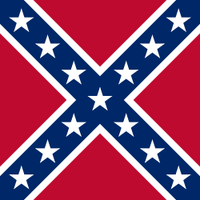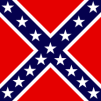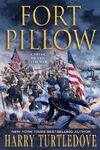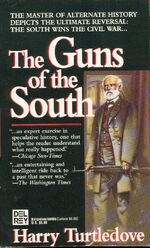
The Battle Flag of the Confederate States of America
The Confederate States Army was the land arm of the Confederate States military while the Confederacy existed during the American Civil War. It was established as a permanent entity in March 1861. After four years of fighting, the Army surrendered throughout the Spring of 1865, and was dissolved with the Confederacy at war's end.
The exact number of men who served is lost due to incomplete or destroyed records. Estimates range between three-quarters of a million to one million men, plus an unknown number of slaves who acted in support roles. Likewise, total casualties are uncertain, but again, estimates suggest 94,000 killed or mortally wounded in battle, 164,000 deaths from disease and between 26,000 and 31,000 deaths in Union prison camps.
The Army was hampered throughout the war by a number of factors. The C.S. had a smaller industrial base than the North, and that was felt in the logistics of maintaining the Army. Throughout most the war, central command of the Army rested primarily in C.S. President Jefferson Davis, with several generals having some degree of control over large parts of the Army. There were also instances of state governments trying to control troops within their respective borders. Robert E. Lee became General-in-Chief in the closing months of the war, but it was too late by then.
Confederate States Army in The Guns of the South
After fighting a larger, logistically-superior enemy for three long years, the Confederate States Army was unquestionably losing the war with the United States by January 1864. A failing supply system meant men were often without proper shoes and uniforms and, as much as some men refused to desert the cause, the C.S. Army appeared headed for certain defeat. All that changed with the surprising arrival of a band of foreign men calling themselves America Will Break and their spectacularly tough and powerful repeating rifle, the AK-47. The AWB, asking only fifty Confederate dollars per rifle, met with Robert E. Lee of the Army of Northern Virginia, promising to re-arm not only the ANV but the entire C.S. Army with the AK-47.
Though Lee himself and his staff were at first skeptical of their ability, the AWB soon not only made good on their promise, but also sent individual AWB members to each regiment of the Army of Northern Virginia to teach the commissioned and non-commissioned officers how to use the AK-47. Those leaders, in turn, trained the rest of the Army of Nothern Virginia. The new weapon proved an instant success with everyone from privates to generals, and morale in the C.S. Army rose swiftly. As both the U.S. Army and the C.S. Army left winter camp, the Army of Tennessee went on a successful offensive and reclaimed large swaths of land that had been in Federal hands for a year or more, and cavalry commanders like Jeb Stuart and Nathan Bedford Forrest launched daring missions to destroy larger Union forces and cut Union supply lines.
The greatest action was by the Army of Northern Virginia, who defeated 40,000 Union troops at the Battles of the Wilderness and Bealeton, virtually obliterating the Army of the Potomac, the core element of Federal military forces in the east. The ANV then advanced on Washington City, aiming to seize it and at long last force Federal recognition of Confederate independence. Though the City was only lightly defended- it had been years since Union planners had seriously expected a Confederate assault there- its forts, heavy artillery, and infantry garrison were far from unprepared. General Lee's bold night attack, aided by some of the AWB men, succeeded in breaking through, and Confederate artillery destroyed a key bridge that stopped the remains of the Army of the Potomac from aiding Washington City's defending garrison during the battle. The C.S. Army captured the White House but did not harm its guards or President Abraham Lincoln. General Lee met with Lincoln, who reluctantly conceded defeat and signed an armistice. With foreign recognition of the Confederate States now guaranteed, the Second American Revolution was effectively won.
The C.S. Army held a victory parade in Richmond, Virginia with both the Army of Northern Virginia and the Army of Tennessee present. With the war over, the Army faced a drawdown and most of its men were dismissed back into civilian life. As peace negotiations went on, the professional Confederate Army was largely posted along the border with the U.S. in case hostilities broke out again. As the Confederacy rebuilt itself, the Army remained busy in the country's south, fighting former United States Colored Troops, Negro soldiers who'd refused to leave and resorted to guerrilla warfare when the rest of the U.S. Army withdrew. Led personally by the famous General Forrest, the C.S. Army battled these rogue fighters fiercely and mercilessly. It took much longer than expected to destroy the last bands of Negro troops, however, making some Confederates- especially Robert E. Lee- wonder if returning blacks to their pre-war status as only animate property was practical or even possible.
After the attempted assassination of now President Lee at his inauguration on March 4, 1868, the Confederate Army besieged the town of Rivington, with the re-commissioned Lieutenant General Forrest in command. The siege lasted for several months, dragged out by the inefficiency of Confederate artillery and the extensive array of advanced weapons used by the Rivington men, which went far beyond just the AK-47. After a ploy by Confederate (formerly Union) Colonel Henry Pleasants, the Confederate Army broke through into Rivington and arrested or killed the AWB's surviving members.
With the AWB members in custody and sharing their secrets in exchange for some clemacy, it was Lee's hope the Confederate States Army would remain one of the most advanced in the world for decades to come.
Confederate States Army in "The Last Reunion"
While the Confederate States Army vanished with the defeat of the Confederacy in 1865, many of its veterans lived long into the years that followed. Veterans' reunions, a common event from almost immediately after the Confederacy's defeat, began to fade as the remaining veterans' numbers dwindled. As they departed, however, the former Confederate States Army soldiers found themselves greeting countless long-vanished comrades in the afterlife. These men, and their old adversaries in the United States Army, relived battles they had fought, healed their wounds, then laughed and talked as friends before repeating the process the next day.
Confederate States Army in "Must and Shall"
The Confederate States Army was broken to pieces along with the Confederate States of America when the United States put down the Great Rebellion and imposed a merciless peace. Many of its leaders, including Robert E. Lee, were executed for treason, as was President Jefferson Davis. All descendants of Confederate States Army soldiers were barred from voting by the Sixteenth Amendment.
Confederate States Army in Southern Victory

The Battle Flag of the Confederate States of America (after the Plebiscites of 1941). It was also used as the CS Military roundel from the Great War in 1914 to the end of the Second Great War in 1944.
1861-1914
The Confederate States Army was formed in 1861, and proceeded to defend the new nation's borders against the United States. Time and again, Robert E. Lee and his subordinates Thomas "Stonewall" Jackson, Jeb Stuart and James Longstreet outfought their Yankee adversaries, culminating in the grand victory at Camp Hill in the autumn of 1862. This victory allowed Britain and France to grant Confederacy diplomatic recognition and force peace upon the U.S.
The rest of the 1800s and the early 20th Century were spent defeating the U.S. once again in the Second Mexican War - most notably at Louisville, Kentucky and in southern New Mexico - and, after 1881, securing the C.S.A.'s hold on Sonora and Chihuahua. Apart from the Second Mexican War, C.S. troops fought against Comanche and Apache Indians and Mexican bandits. The Confederate army frequently maintained conscription in response to the US introducing conscription after the Second Mexican War although it was not universal in the confederacy. CS Troops also frequently maintained a military presence on all borders with the US in the event of war breaking out.
The main influences on the Confederate army were its Entente allies, Britain and France. The confederacy adopted British khaki uniforms, calling them butternut for historical reasons. They also adopted the British tin hats and manufactured their own copy of the Lee-Enfield rifle, calling it the Tredegar rifle after the Tredegar Iron Works in Richmond. The Confederates also adopted the French 75mm field gun as their standard artillery piece.
1914-1917 (The Great War)
1914
During the Great War, Confederate troops initially had great success on the Eastern Seaboard, occupying Washington and coming close to taking Philadelphia. On other fronts, the Confederates were mostly content to stand on the defensive, forcing their US opponents into grinding battles of attrition. The war of attrition was especially bloody on the Roanoke Front and in Kentucky, where General George Armstrong Custer's First Army kept being launched on reckless frontal attacks against heavily entrenched Confederate positions.
1915
In 1915, the CS Army's position was weakened by the need to divert large numbers of Confederate troops to put down a wave of socialist black uprisings in the Confederate heartland. While these uprisings were brutally crushed, it took considerable time and energy to defeat them and to hold down the countryside afterward.
1916
By 1916, the Confederates were beginning to lose the ground war. The US was making liberal use of a variety of new weapons, including poison gas, flamethrowers, and heavily armored tracked vehicles called barrels. Barrels could defeat barbed wire and machine guns easily, allowing US infantry to break Confederate defenses. The Confederates were gradually pushed back through Pennsylvania and Maryland in the East, Kentucky in the Midwest, and Sequoyah in the West. In desperation, the CS Army allowed large numbers of blacks to volunteer in return for the right to vote, to attempt to bolster their worn-down front-line formations. The black troops proved to be of variable reliability to the Confederate cause.
1917
In 1917, the Confederate Army was no longer able to hold back the US advances into Virginia and Tennessee. When the Confederate States surrendered, the Confederate States Army was largely disarmed, being restricted to only a handful of machine guns for the entire country and forbidden from constructing barrels or other advanced weapons.
1917-1941 (Between the Wars)
The Confederate Army faced severe restrictions on its size and armament after the Great War. Barrels and aeroplanes were forbidden, and the size of the army was severely curtailed. The Confederacy circumvented these restrictions by sending "volunteers" to fight in various wars around the globe, including the civil wars in Mexico and Spain, and a conflict involving Peru and its neighbors. When the Freedom Party came to power, they began expanding the army, using the Negro rebellions as an excuse to swell its size, and reintroduced conscription.
1941-1944 (The Second Great War)
1941
During the Second Great War, Confederate troops initially won many victories and were more effective in battle than their United States counterparts. Most Confederate infantrymen were armed with submachine guns or the Tredegar Automatic Rifle, giving them an individual advantage in firepower over US infantrymen still armed with bolt-action M1903 Springfield rifles. The C.S. Army was well-trained in combined-arms operations and made extensive use of it, adding columns of barrels and close air support craft such as their deadly Mule. The Mule dive bomber was known by US troops as the "Asskicker" due to its devastating firepower, and was dreaded for its distinctive wailing siren that activated when it went into a dive. C.S. Army artillery utilized a towed 105mm howitzer as its standard piece, and despite more than 80 years of separation both C.S. and U.S. Army forces used .45 caliber pistols.
Aggressive action and innovative use of combined-arms tactics allowed CS forces under the command of General George Patton to drive across the Ohio River and through the state of Ohio, cutting the US in half. Patton's seemingly-limitless drive and energy galvanized the troops under his command, making the early days of the war filled with victories for the Confederate States Army. Cutting the United States in half impeded the US war effort by making it impossible to ship supplies from east to west except by rail through Canada, by water through the Great Lakes (subject to Confederate interdiction) or by air (also subject to Confederate interdiction). Both sides made extensive use of poison gas during this campaign.
After the fall of Sandusky, the Ohio front would be a relative stalemate. Later in 1941, US forces attempted to copy the Confederates' success and launch a drive on Richmond, Virginia, which, after some initial success, was halted by Confederate forces. Both sides would grind at each other until the drive into Pennsylvania in June. The Virginia front would be largely inactive until early 1944.
1942
Despite the success of the Ohio campaign militarily, it failed strategically as the US did not give in. C.S. Army planners had aimed for a quick and decisive victory, but with the United States government refusing to surrender or even negotiate, the Army found itself facing a much longer and more difficult war.
President Jake Featherston ordered another major offensive, this one aimed at taking the major US industrial city of Pittsburgh. However, the US forces, now under the command of the aggressive and brilliant-minded tactician General Irving Morrell, began to display greatly improved performance and forced the Confederates to push into Pittsburgh itself instead of the original plan to surround the city and besiege it. They were gradually ground down in house-to-house and later rubble-to-rubble fighting. In November 1942, a US counterattack under the command of General Morrell cut off the Army of Kentucky inside Pittsburgh and rapidly retook most of the Confederate holdings in Pennsylvania and Ohio. Patton had to be ordered to leave the city by Featherston and was flown out before the besieged and surrounded Confederate forces there surrendered. From then on, the United States would have the initiative.
1943
During 1943, the Confederates were forced onto the defensive all along the line, gradually being forced to yield ground in West Texas (where the US Eleventh Army under Abner Dowling overran the Confederate concentration camp called Camp Determination), Virginia, and especially in Kentucky and Tennessee, where Morrell continued to press Patton's forces in an attempt to employ the Confederates' own tactic of cutting the enemy nation in two against them. The end of 1943 saw Confederate forces struggling to halt the US advance in northern Georgia short of Atlanta, despite the advantage of having several novel weapons such as the Barrel Busters (a self-propelled antibarrel gun on a barrel chassis), the stovepipe (an anti-barrel rocket launcher) and a number of other rocket artillery weapons.
1944
By 1944, the Confederate States Army was on its last legs. Several years of all-out war had sapped its manpower and available fuel and equipment to disastrously-low levels. With United States troops advancing everywhere, the Army was forced to call on its last strength. New recruits were hastily enlisted and sent into action, as the Army called on the only reserves it had left untapped - the old men and the young boys. Though the new Barrels with their thick armor and massive guns were superior to the United States Army's Mark IIIs, they were too few in number to be able to stop the U.S. advance.
The Army fought on to the bitter end as Jake Featherston demanded, but with his death and the threat of further use of nuclear weapons against Confederate territories, the C.S. Army finally gave up. General George S. Patton, commanding general of the Army of Kentucky, had by the war's end retreated to Birmingham, Alabama, where he surrendered to Brigadier General Ironhewer. With Patton's surrender, the C.S. Army's last real hope of carrying on evaporated. Surrendered soldiers were taken in as prisoners of war, and were required to swear an oath of loyalty to the United States before they would be released. The Confederate States Army, like the country it served, ceased to exist 83 years after it was established.
| ||||||||||||||||
| |||||||||||||||||||
| ||||||||
| ||||||||












